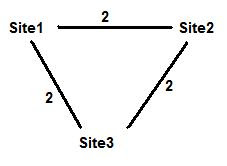
In this diagram there are 4 ways to get from Site1 to Site3.
Site1 -> Site2 -> Site3 = Cost 20
Site1 -> Site4 > Site3 = Cost 25
Site1 -> Site2 -> Site4 -> Site3 = Cost 31
Site1 -> Site4 -> Site2 -> Site3 = Cost 16
Site1 -> Site4 -> Site2 -> Site3 provides the lowest cost however exchange 2007 will use the path of the least hops with lowest cost... which in this case is Site1 -> Site2 -> Site3. Additionally when messages are realyed from Site1 -> Site2 -> Site3, messages will not hit Site2 hub transport server, it will just use the subnet information in sites and services to send it in that direction. This is because if Site2 hub transport had to recieve every email that comes through, it would use extra processing.
What if Site2 was responsible for spam filtering and you wanted email going from Site1 -> Site2 -> Site3 to actually pass through Site2's hub transport server?
This can be done by setting Site2 as a "Hub Site" by using the Set-ADSite command. This means that all messages flow along this journey must stop in site2 before being relayed on.
What if an exchange administrators wanted to to setup email replication different to active directory sites and services replication?
If you are not happy with the site link costs in AD, instead of updating sites and services you can use the powershell command Set-ADSiteLink to set new costs to that site link for exchange. This does not modify the value in sites and services. It only effects exchange. Whenever an exchange site link cost is specified, it will use this instead of the site link cost specified in AD Sites and Services. Very handy if you want mail to flow in a different direction to your AD replication.

We want to get messages flowing from Site1 -> Site2 -> Site3, and not Site1 -> SIte3. We do not want to modify active directory site links. What needs to be done?
Answer
To perform this we need to do 2 things:
- First make site2 a "hub site" by using the Set-ADSite cmdlet.
- Second use the Set-ADSiteLink on the site1-site3 sitelink and make it a value of 5 or higher.
Conclusion
Provided your Active Directory Sites and Services is setup correctly in regards to site links and costs to reflect your physical network infrastructure, this should give you all the knowledge you need when it comes to the Exchange 2007 site to ensure your messages flow throughout your organisation efficiently and effectively.
If you have any questions feel free to drop me an email clint@kbomb.com.au
Hello, guys! I understand the principle of work of the mail flow but there is one thing that remains unclear to me - what is the purpose of this flow, what kind of benefit it can actually bring?
ReplyDeleteLiza, developer of mp4 to mp3 converter free